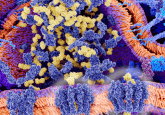Could acoustofluidic platforms be the future of oropharyngeal cancer detection?

An international collaboration between researchers based at Duke University (NC, USA) University of California Los Angeles (CA, USA) and the University of Birmingham (UK) have developed a novel saliva exosome liquid biopsy that could be capable of detecting human papilloma virus-16 (HPV-16), a strain associated with oropharyngeal cancer.
Oropharyngeal cancer is often only diagnosed in the advanced stages, in part due to the difficulty of examining the back of the mouth and upper throat in routine clinical exams. In this study, scientists describe the analysis of saliva samples as a noninvasive test for HPV-16.
The novel, noninvasive technique, reported in The Journal of Molecular Diagnostics, makes use of an acoustofluidic platform to isolate and detect HPV-16 from salivary exosomes – microvesicles that are secreted into bodily fluids from cells. In the study, saliva samples were analyzed using an acoustofluidic chip which isolates salivary exosomes through a size exclusion process, resulting in a highly concentrated sample, thus facilitating the detection of tumor specific biomarkers.
Saliva samples from 10 patients with a confirmed HPV-16 oropharyngeal cancer diagnosis were analyzed using the acoustofluidic chip coupled with droplet digit PCR. The technique successfully identified the tumor biomarker HPV-16 in 80% of the samples. Importantly, this method shows promise for use in a clinical setting because it is not affected by sample variability introduced by changes in the collection method used or saliva viscosity.
Clinical utility may also be bolstered by the technique’s automated and fast exosome isolation, relatively low cost and the ability to perform analyses at the point of care. The noninvasive nature of the technique makes it suitable for the continuous monitoring of tumor progression and treatment success.
Tony Huang, co-lead investigator (Duke University) stated: “With these features, the acoustofluidic technology has the potential to significantly exceed current industry standards, address unmet needs in the field, help expedite exosome-related biomedical research and aid in the discovery of new exosomal biomarkers.”
Co-lead author, David Wong (University of California Los Angeles) explained: “The acoustofluidic separation technique provides a fast, biocompatible, high-yield, high-purity, label-free method for exosome isolation from saliva.” The scientists hope that the technology could also be used to analyze other biofluids in the future, including blood, urine and plasma.
Sources: Mehanna H, Wong DTW, Huang TJ et al. Acoustofluidic salivary exosome isolation: a liquid biopsy compatible approach for human papillomavirus–associated oropharyngeal cancer detection. J Mol Diagn doi: 10.1016/j.jmoldx.2019.08.004 (2020) (Epub ahead of print); https://www.eurekalert.org/pub_releases/2019-12/e-sts121119.php



